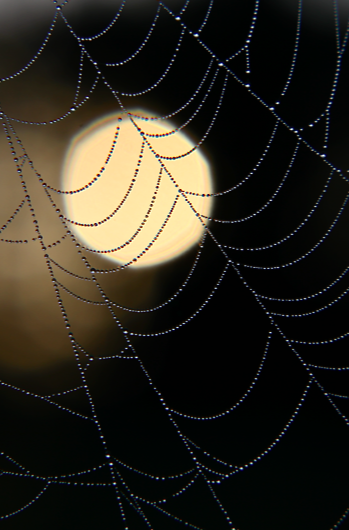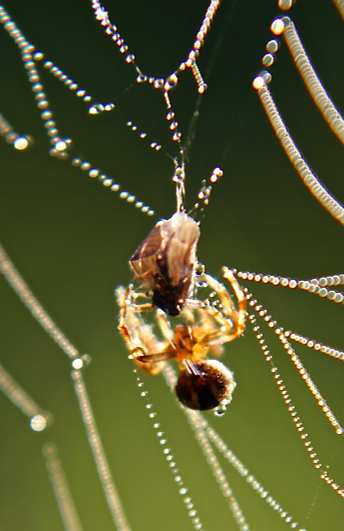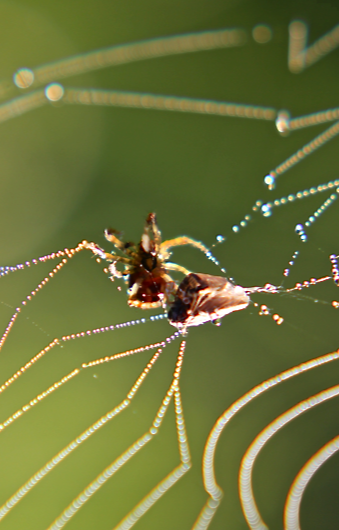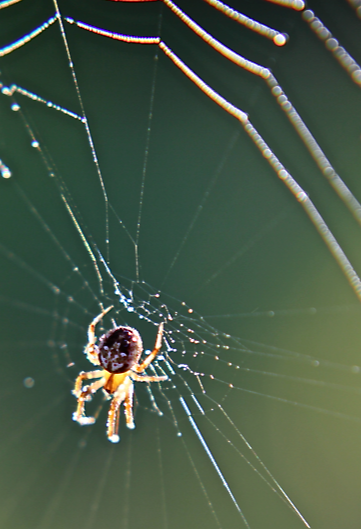Gordon Grice's Blog, page 54
June 4, 2012
Pentecostal Pastor Dies in Snake-Handling Ceremony

A man who handled a timber rattlesnake as part of his church service has died from a bite. Venomous snakes have killed more than 100 people in the history of this Charismatic religious movement.
'Serpent-Handling' West Virginia Pastor Dies From Snake Bite - Yahoo! News:
"30 minutes into the outdoor service, Wolford passed around a poisonous timber rattlesnake, which eventually bit him.
"He laid it on the ground," Vanover said in the interview, "and he sat down next to the snake, and it bit him on the thigh.""
Published on June 04, 2012 03:00
June 3, 2012
Dolphin Bites People
It's the familiar story of an animal habituated to humans and perhaps expecting food from them.
Rogue dolphin attacks swimmers in Louisiana - UPI.com: "SLIDELL, La., May 29 (UPI) -- A rogue dolphin living in a canal in Slidell, La., has been attacking swimmers and boaters, and little can be done about it, authorities say.
The male dolphin has only recently become aggressive, after taking up residence in the canal behind the Lakeshore Estates subdivision after Hurricane Katrina, WVUE-TV, New Orleans, said Tuesday, reporting one person was bitten last week as he was standing in a boat and washing his hands in the water."
Published on June 03, 2012 03:00
June 2, 2012
Kangaroos Attacks Football Team, Family
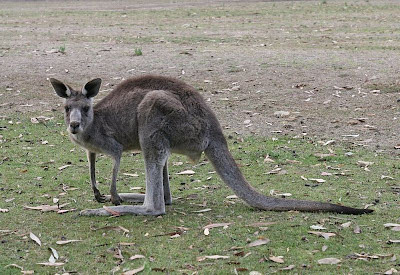
A kangaroo's recent attack on a children's football team is said to be unprovoked. Some details:
Hunt for a "berserk" kangaroo: Animal that attacked children and a pregnant woman will be destroyed when found - Mirror Online:
"Australian park rangers hunting down a kangaroo that left two people hospitalised after it went “berserk” during an attack on children and a pregnant woman intend to shoot the beast when it has been located.
An eight-year-old boy who needed 20 stitches and a pregnant woman who suffered a laceration after being kicked in the stomach were among those injured by the eastern grey kangaroo last week.
The marsupial turned aggressive as an under-7s football team were training on the Jervis Bay school grounds on the New South Wales south coast.
Booderee National Park services manager Dr Martin Fortescue told abc.net.au that the kangaroo was growling, charging at people and appeared disturbed.
"It wasn't going to back off at all and that's something I must say I haven't seen before," he said."
Meanwhile, a different kangaroo harassed a family for several days, attacking wife, husband, and dog.
Woman says kangaroo stalked her, then attacked - TODAY Pets & Animals - TODAY.com:
"McWilliams was picking her daughter up from the school bus when the kangaroo charged her in her driveway. The kangaroo pounded and scratched her and left a 12-inch gash on her back after she curled up into a ball on the ground with nothing to hide behind, according to The Daily Telegraph."
The news stories are calling this "stalking," but that's misleading. Kangaroos aren't predators, so they don't stalk other animals to eat them. And this one is not likely to have plotted its violence against specific people. It's more likely the kangaroo became habituated to human presence and began to think of the humans and the dog as intruders in its territory.
Published on June 02, 2012 02:30
June 1, 2012
Animal Attack Movies: Jaws
 Survivors of the USS Indianapolis
Survivors of the USS IndianapolisJaws (Steven Spielberg, 1975)
This movie dips into history for two important shark incidents. One is the New Jersey attacks of 1916. Five people were killed in a few days that summer, at least three of them by the same shark. Commentators at the time theorized that the shark was a “rogue,” because in less enlightened times, all animals that attacked humans were considered aberrations. The movie borrows that theory, and adds the notion of territorial defense to the shark’s motives. (Nobody buys those motives anymore.) The other bit of history in Jaws is the sinking of the Indianapolis, the ship that delivered the components of the atomic bomb dropped on Hiroshima. Sharks devoured hundreds of men as they waited for rescue. In a famous monologue, Robert Shaw’s character recounts that incident: “You hear the terrible high-pitched screaming. The ocean turns red.” The movie also owes a lot to Moby-Dick, the greatest animal attack novel, which was itself based on the true story of the whaler Essex, destroyed by a sperm whale. The survivors drifted away in life boats, eventually resorting to cannibalism.
Published on June 01, 2012 03:00
May 31, 2012
Bull Shark Bites Off Fisherman's Hand

In Shark Attacks: Inside the Mind of the Ocean's Most Terrifying Predator
 , I mention the bull shark's habit of removing human hands. Today's news provides another gruesome instance. The story linked below is in Spanish, but Croconut gives us the gist in English:
, I mention the bull shark's habit of removing human hands. Today's news provides another gruesome instance. The story linked below is in Spanish, but Croconut gives us the gist in English:Tiburón le devora una mano:
In Boca de la Leña, a beach in the state of Guerrero, Mexico, a bull shark attacked a fisherman, biting off his left hand.
According to Juan Mendoza, the fisherman partner to Benigno, the attacked man, both were diving five meters from the shore, fishing for snook, when suddenly a shark appeared. According to Juan, when he saw the shark, it already had his partner's hand in its mouth; it didn´t return for a second attack-- it "swam away eating his hand".
After the attack, Juan dragged Benigno out of the water and took him to the hospital, where he remains in critical condition due to blood loss. He could, however, describe the moment of the attack to the press; "I didn´t feel when the shark bit my hand off; we were fishing and I didn´t even see it coming; my partner Juan took me and brought me quickly to the hospital, I was dizzy for all the blood I lost but thank God I'm OK; I will continue fishing because it's the only thing I know and I have a family to maintain".
This is the first shark attack in a Guerrero beach in four years.
Published on May 31, 2012 02:00
May 30, 2012
Breakfast Wrap
Published on May 30, 2012 03:00
May 29, 2012
Giant Mice Ravage the Land
Ordinary domestic mice, introduced by humans, are wreaking havoc on the bird populations of Gough Island, where no predators can stop them.
Mice in Gough Island killing endangered atlantic petrel bird | Global Animal:
"There are about 1.9 million mice on an island that’s just 25 square miles (65 square kilometers). What’s more, the mice on Gough Island now grow 50 percent bigger than normal mice, reaching up to 10 inches (27 centimeters) long, not including the tail.
As other food sources diminish in winter, the mice turn to the huge numbers of bird chicks.
For example, mice have been known to attack and eat chicks of the Tristan albatross, a ground-nesting bird—even though an albatross nestling weighs 300 times more than a mouse."
Mice in Gough Island killing endangered atlantic petrel bird | Global Animal:
"There are about 1.9 million mice on an island that’s just 25 square miles (65 square kilometers). What’s more, the mice on Gough Island now grow 50 percent bigger than normal mice, reaching up to 10 inches (27 centimeters) long, not including the tail.
As other food sources diminish in winter, the mice turn to the huge numbers of bird chicks.
For example, mice have been known to attack and eat chicks of the Tristan albatross, a ground-nesting bird—even though an albatross nestling weighs 300 times more than a mouse."
Published on May 29, 2012 03:00
May 28, 2012
A Better Mousetrap
 Rama/Creative Commons
Rama/Creative Commonsby guest writer Darlene West
We had been country dwellers for maybe a year when my husband, John, suggested casually one morning on his way out the door that we should pick up some mouse traps.
I drained my cup of coffee, dashed outside, and found him near the Quonset hut, tossing his wire cutters and Gripple tighteners behind the seat of his tractor.
“Did you see one?” I asked.
“See what?”
“A mouse. Did you see a mouse in the house?”
“Just some droppings,” he said. “In the mud room, inside the basement door.” He grabbed his hearing protectors, hopped on the tractor, and turned the key.
“We’ll just get some traps,” he shouted over the roar of the engine. He slipped the tractor into reverse and looked over his shoulder. Then he guided the rear forks under a stack of wooden bins, picked them up, and drove away. Our Border Collie, who had been asleep under a plum tree near the creek, jumped to his feet and followed.
I sauntered back to the empty house. In my basement office, I turned on my laptop, but I couldn’t focus. Would the mouse stay near the back door, I wondered, or venture deeper into the house? Would it head for the kitchen? A cupboard? A closet? It could be right in my office. I imagined finding the mouse in my desk drawer or taking a book off my shelf and meeting its whiskered face.
Alone in the house, I heard clicks and scratches I’d never noticed before. A heater squeaked, a floorboard cracked, a water softener hissed. Easy for John to be so blasé, driving his tractor through open fields where mice had their own lives and their own space.
My morning was already half wasted. I Googled “mouse extermination.”
When I opened the link to Trusty Rodent Removal a male voice boomed out of my laptop: “If you have mice affecting your property, you’ve come to the right place.”
I lowered the volume and listened to a 60-second spiel on how mice enter a wall cavity and den up in an attic or crawl space to have their young, how the young mice chew on electrical wires causing fires, how they sometimes die, causing odour problems. “Mice, like rats, will often infest a building for years, causing the building to lose its value.”
The Trusty Rodent Removal site had a wild animal information section with a substantial area devoted to mice. A photograph of what I took to be a dead mouse appeared above the caption: “view our mouse photo gallery.” I turned, instead, to the FAQ section, which addressed a dozen or so questions ranging from “What do mice eat?” to “Will mice hurt my dog?”
Mice, I learned, have litters of five to six babies that grow up fast. “They’ll be independent in about a month.” Multiply that by 5 or 10 litters a year. “You can see how one or two mice in the attic or walls can become 20 in no time.”
I couldn’t stop reading. I wanted to read that mice quite often slip in through an open door, hang out near the entry, and leave. Instead, I read how mice get into your house in the fall by climbing right up the wood siding or brick. Or even by jumping or swimming. “Mice will tear into areas of your home or business and haunt it for years to come. Sometimes, so many shack up that the space becomes a mouse hotel.”
On the drive to town, I thought about life in a mouse hotel and felt a sad longing for the person I was before I knew about mice. It was tourist season. I envied the passengers in the cars I passed on the highway. People like me before I became aware that mice enjoy living in large electrical spaces such as the back of ovens. Before I knew that mice will eat anything and are not afraid of trying new foods. Before I learned that once mice get into your walls you can hear them climbing, squeaking, and fighting right above your head. I wished I could send this information back where it came from.
In the hardware store, I picked up a package of Victor conventional wooden mouse traps. On the same shelf, a round, plastic device caught my eye – a better mouse trap, the package said. The idea of the plastic trap was that the top, when shut, would cover the dead mouse so the user would never have to see or touch the body. I took the better mouse trap as well.
Later that evening we baited the wooden traps with cheese and placed them on window ledges and shelves around the basement where our dog wouldn’t spot them. Some traps were more sensitive than others. They sprung shut with a snap when we set them on the floor and had to be reset. I put the better mouse trap in a closet in a storage room.
The next morning, I was in my office when John got back from an early run and heard a persistent clacking noise that he traced to the storage room in the basement. He opened the door.
A mouse screamed across the floor and thrashed and crashed and tried to climb the wall. The better mouse trap was firmly attached to its tail.
I’d heard the clacking noise, of course. How could I not? Even with all I had read about rodents that racket was hard to believe. But I didn’t budge. I stayed at my desk. You wouldn’t discover a trapped mouse and then just walk away. A rodent would be dealt with by the person who found it.
I was certain that wouldn’t be me.
Gordon's note: Trusty Rodent Removal, whose website is quoted in Darlene's story, is a made-up name for a real company. We found the same scary copy on many exterminators' websites. The claim that mice "will tear into areas of your home or business and haunt it for years to come" appeared on a number of sites, in precisely those words, except that "mice" was often replaced with "rats," "skunks," or even "armadillos." "Trusty" also says that once mice figure out how to get into your house, bees, bats, and chipmunks follow the same route. The company stands ready to handle all of these pests, along with woodpeckers, toads, and wild pigs.
Darlene West is a photographer and freelance writer; visit her at http://www.darlenewest.ca/. She lives and works on a vineyard in the Okanagan Valley in British Columbia.
Next: Giant Mice Ravage the Land
Published on May 28, 2012 02:30
May 27, 2012
Moose in the Yard
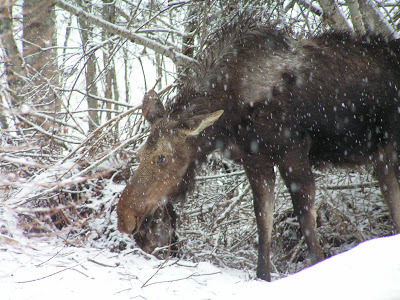
"From Idaho: the crazy moose cow that used to terrorize the yard where I was living. She trapped me in the house one night, because she got angry at the dogs for barking at her and our backdoor was snowed shut at the time. It was kind of funny to me, to call into work and tell them I was going to be late because I was being held hostage by a moose."--Dee Puett, photographer





Published on May 27, 2012 02:00
May 26, 2012
Coatis Aid Juvenile Delinquents

An interesting behavior, previously unknown except in humans, has turned up in the coati (or coatimundi). It appears that the females sometimes side with unrelated juveniles against their own relatives.
Females Coatis Help Unrelated Offspring Steal Food | LiveScience:
"Coatis, which are found in South America, are a highly social species related to the raccoon and known for being particularly aggressive, especially when it comes to food. They live in cohesive groups of up to 65 individuals that usually include only a single adult male.
Over the course of the three-year study, Hirsch monitored the behavior of 150 individual coatis in four social groups in Iguazu National Park in Argentina. Using genetic data, he found that in 57 percent of the cases in which an adult female helped a juvenile during an aggressive encounter, the female was not the mother of the juvenile."
Published on May 26, 2012 02:00

